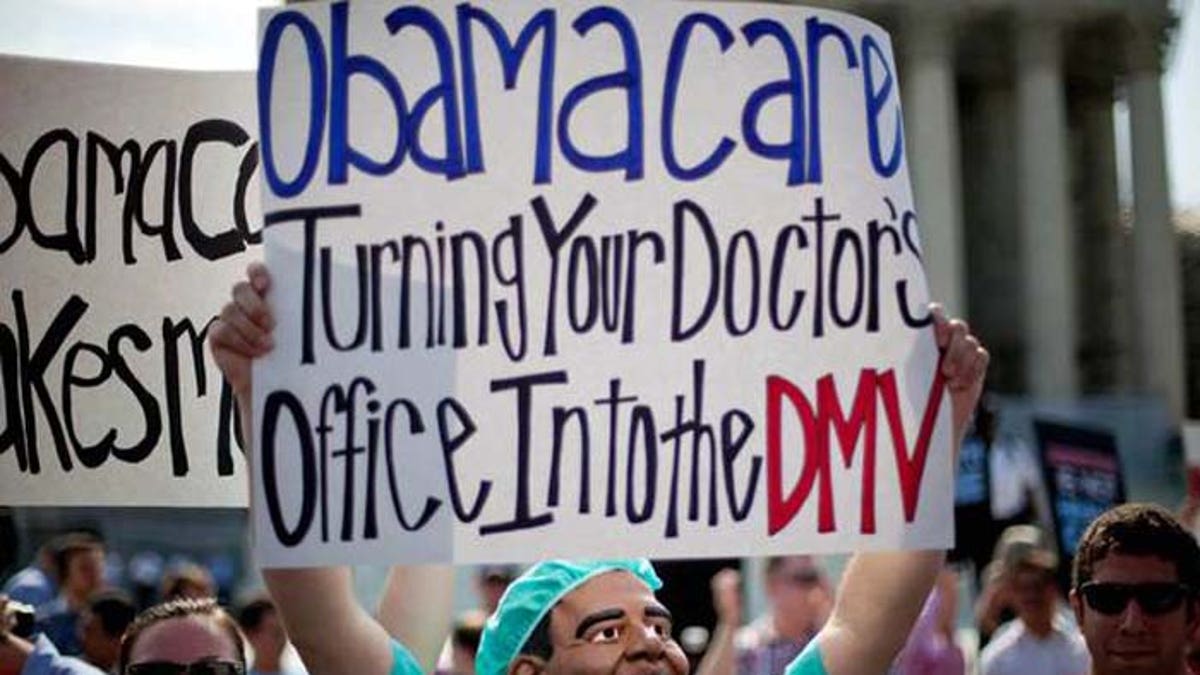
A short-term alternative to President Obama's controversial health care plan could rob exchanges of the healthiest customers. (AP)
A fast-growing, short-term alternative to ObamaCare that allows customers to get cheap, one-year policies could put the government-subsidized plan into a death spiral.
The plans, the only ones allowed for sale outside of ObamaCare exchanges, generally cost less than half of what similar ObamaCare policies cost, and are increasing in popularity as uninsured Americans grapple with the requirements of the Affordable Care Act. The catch -- that the policies only last for a year -- is not much of a deterrent, given that customers can sign up for ObamaCare during open-enrollment periods if their short-term coverage is not renewed.
“Applications rose 30 percent compared to last year,” eHealthInsurance.com Enrollment Specialist Carrie McLean told FoxNews.com.
Other providers said they also see rapid growth in the plans, which have a typical monthly premium of just over $100, compared to traditional plans that cost an average of $271.
“It’s because the product is typically half the cost of ACA plans, and you can chose any doctor or hospital,” Health Insurance Innovations CEO Mike Kosloske told FoxNews.com.
[pullquote]
As long as customers stay healthy, they can renew the short-term plans. If patients get sick while covered, the plans provide for their care until the end of the term, when customers can be declined. But such plans can work well with ObamaCare, because if stricken policyholders can still buy insurance through the Affordable Care Act, where insurers must charge sick and healthy people the same rate.
Some people with these plans just buy them as a stop-gap between jobs or to wait until ObamaCare-approved plans go on sale again on Nov. 15. But Health Insurance Innovations says that 40 percent of people are repeat customers who buy one short-term plan after another.
In theory, if enough young and healthy people switch to short-term, non-ObamaCare plans, it could cause a “death spiral” for ObamaCare plans where prices soar and healthy customers look elsewhere.
"If the ObamaCare health insurance exchanges are to function properly, it is crucial that a substantial number of people ages 18-34 join them," the National Center for Public Policy Research wrote in a study last year. "This age group that is young and relatively healthy must purchase health insurance on the exchanges in order to "cross-subsidize" people who are older and sicker. Without the young and healthy, the exchanges will enter a "death spiral" where only the older and sicker participate and price of insurance premiums will increase precipitously."
However, supporters of ObamaCare say the program's taxpayer-funded subsidies will keep customers from bolting.
“I really don’t think a lot of people are going to buy these policies because with these, people can’t get the financial assistance they can get in the [ObamaCare] marketplace,” Cheryl Fish-Parcham, Private Insurance Program Director at the pro-ObamaCare Families USA told FoxNews.com.
She added that, except for people in unusual circumstances, the short-term plans are not a good deal.
“There are a lot of protections that they are missing out on. For instance if you have pre-existing condition, you are going to be rejected. If you get pre-existing condition while on the plan, that insurer is not going to sell to you again.”
There is another catch to having short-term insurance: Customers still have to pay the tax penalty for not having ObamaCare insurance. That fine is $95 annually per person, although it has been waived for those who lost their insurance due to ObamaCare. But by the year 2016, it will rise to a more substantial $695 per person or 2.5 percent of your income (whichever is greater.)
But Kosloske of Health Insurance Innovations says even with the fine, it is still worth it for most people to go with temporary insurance for now, unless their income is low enough to qualify for the largest subsidies.
“Basically, people making $37,000 or less should go on ObamaCare. People with serious pre-existing conditions -- they should go on ObamaCare. But for everyone else, including the penalties and including the subsidies [for ObamaCare plans], we cost 30-50 percent less and have that freedom of choice with providers.”
Health Insurance Innovations estimates that the short-term insurance industry as a whole has grown at 20-30 percent over the last year since ObamaCare was implemented. McLean, of eHealthInsurance.com, said the plans appeal to young people.
“They're particularly popular with young adults," she said. "Forty-six percent of our short term policy holders are between the ages of 25 and 34.”
One conservative youth advocacy group, Generation Opportunity, specifically endorses buying short-term plans as a way to get around ObamaCare.
“We think it is an excellent option for young people,” the group’s president, Evan Feinberg, said, though he added that it isn’t perfect.
“We don’t think this is an ideal way to do health insurance in general. People should be free to insure themselves both against short-term catastrophic costs and the long term need for permanent medical care,” he said.
“Unfortunately there are people who take away that choice from us based on a misguided idea that they can run a healthcare system from Washington that meets the needs of hundreds of millions of Americans.”
Maxim Lott can be reached on twitter at @maximlott or at maxim.lott@foxnews.com




